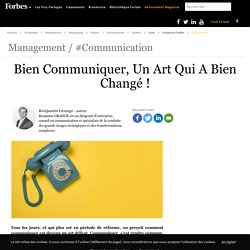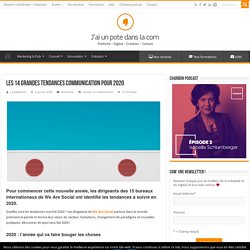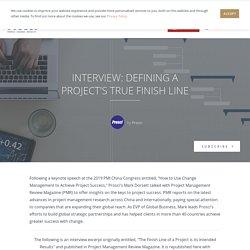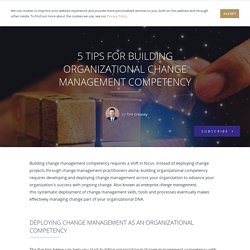

6 Ways to Build Trust During Organizational Change. Death and taxes have traditionally been viewed as the two guarantees in life, but I think a third item has officially made the list: change.

The pace of change accelerates with each passing, day, month, and year. The exponential growth of technology has enabled new products, services, and businesses to rise to prominence in short order, and has caused others to become obsolete just as quickly. Yet research has shown that 70% of all organizational change efforts fail, cost more, or take longer than expected.
Leading people through change is not a natural-born talent for most people. It’s a skill that must be developed and practiced over time for leaders to become comfortable navigating the complexities of organizational change. The one must-have ingredient of successful change efforts is trust. Bien Communiquer, Un Art Qui A Bien Changé ! GettyImages-1147048229 | Source : GettyImage.

Les 14 grandes tendances communication pour 2020. Pour commencer cette nouvelle année, les dirigeants des 15 bureaux internationaux de We Are Social ont identifié les tendances à suivre en 2020.

Challenging Our Gendered Idea of Mentorship. Executive Summary Conversations on the topic of sponsorship, mentorship, and allyship are often about how male leaders can help women.

These narratives are important and necessary, but they also offer a narrow definition of leadership, portraying men as the heroes in a story where women need help. Interview: Defining A Project's True Finish Line. Following a keynote speech at the 2019 PMI China Congress entitled, "How to Use Change Management to Achieve Project Success," Prosci's Mark Dorsett talked with Project Management Review Magazine (PMR) to offer insights on the keys to project success.

PMR reports on the latest advances in project management research across China and internationally, paying special attention to companies that are expanding their global reach. As EVP of Global Business, Mark leads Prosci's efforts to build global strategic partnerships and has helped clients in more than 40 countries achieve greater success with change.
The following is an interview excerpt originally entitled, "The Finish Line of a Project is its Intended Results" and published in Project Management Review Magazine. It is republished here with permission. Resilience in Uncertain Times: Insights From Global Leaders. IDEO’s global client and partner network gives us a unique view into how organizations are responding to rapid change.

Recently, we decided to ask our clients what problems are keeping them up at night, and what promising solutions keep them leading with optimism. We reached out to 55 global business leaders spanning 25 cities and 18+ industries. What we heard is that while uncertainty isn’t new, there have never been so many compounding causes for concern. A decade ago, it was easy to see what triggered the recession. 5 Tips for Building Organizational Change Management Competency. Building change management competency requires a shift in focus.

Instead of deploying change projects through change management practitioners alone, building organizational competency requires developing and deploying change management across your organization to advance your organization's success with ongoing change. Also known as enterprise change management, this systematic deployment of change management skills, tools and processes eventually makes effectively managing change part of your organizational DNA. Deploying Change Management as an Organizational Competency The five tips below can help you start building organizational change management competency with focus and intent. 1.
Building organizational change competency does not occur as a single announcement or leadership decree. 4 Reasons Warm-Ups Will Fundamentally Change Your Work. Did you just cringe?

Perhaps your nostrils flared in suspicion. I’m at the far end of the extroverted spectrum and even I have on that grimace. I’m here to talk to you about creative warm-ups, and to once and for all distinguish them from their brash, single-toned—that tone being forced, high-energy social interaction—cousin: the dreaded icebreaker. But first, a brief interlude for sports.
If you have played or watched any sport on the planet, you know that athletes do not run straight onto the field, into the pool, or out on the court. How to explain anything to anyone: 4 steps to clearer communication. Priya Mistry This post is part of TED’s “How to Be a Better Human” series, each of which contains a piece of helpful advice from people in the TED community; browse through all the posts here.

“Have you ever had this experience?” Asks physicist Dominic Walliman in a TEDxEastVan Talk. “You’re having a chat with someone, and they’re telling you something about a subject they’re very interested in or they know a lot about, and you’re following along. The Correlation Between Change Management and Project Success. The need for greater recognition of change management and its value often tops the list of trends in our benchmarking research.

Cracking the Code of Sustained Collaboration. Ask any leader whether his or her organization values collaboration, and you’ll get a resounding yes. Ask whether the firm’s strategies to increase collaboration have been successful, and you’ll probably receive a different answer. “No change seems to stick or to produce what we expected,” an executive at a large pharmaceutical company recently told me. Most of the dozens of leaders I’ve interviewed on the subject report similar feelings of frustration: So much hope and effort, so little to show for it. Infographic: 6 Tactics for Growing Enterprise Change Capability. Our clients depend on their enterprise change capabilities to manage the volume and pace of change they face today. Especially when globalization, merger activity, digitalization, and countless disruptions in technology can make them vulnerable. We decided to engage with 10 industry innovators to understand how they're prioritizing organizational change competency as a strategic objective.
Here are the six universal and effective tactics we uncovered, which help these and other organizations achieve higher project ROI, better productivity, less employee resistance, and other benefits. Select the Right Communication Channels for Deskless Employees. Employees not tethered to a desk can be hard to reach, but these nonwired employees must be a priority for corporate communications leaders.
Are your employees frequently on the road or away from the office (sales reps, consultants)? Are they on company property, but not connected by phone or computer (production line workers, cleaners, catering staff)? Or just too busy with day-to-day activities to use their computer, email or phone (call center agents, nurses, doctors)? Gartner classifies “nonwired” employees into three groups: Nonwired and stationary: Employees without an electronic connection, such as a company phone or computer.Nonwired and on the road: Employees who spend the majority of their time away from company sites.Wired but busy: Employees who have access to email, phone and computer, but don’t have the time to check them frequently.
Tim Talks: The Change Management Maturity Model. Tim Talks is an ongoing series of short videos featuring conversations between Tim Creasey, our Chief Innovation Officer, and the people of Prosci. How to Increase Your Influence at Work. To be effective in organizations today, you must be able to influence people. Your title alone isn’t always enough to sway others, nor do you always have a formal position. So, what’s the best way to position yourself as an informal leader? How to Write Company Manifesto That Creates a Better Work Culture. Creating a positive culture empowers staff at all levels to call out problems and point your team toward a shared goal.
October 18, 2019 6 min read Opinions expressed by Entrepreneur contributors are their own. Our office is probably a lot like yours. It operates with both spoken and unspoken “rules” that guide the ways we work together. Spoken norms are things like dress code policies, what time the workday starts and how staff reviews take place. The sooner we acknowledge and determine what those norms are in our workplaces, the happier, more open and more confident people will be.
Related: The Entrepreneur Manifesto for 2019: Forget the Resolutions, Build a Culture Instead We're not the only ones. Cultivating an office culture focused on how people operate within that office has been our highest priority from the beginning, too, and our manifesto let us put that belief into action. Having this document has transformed us. 1.
5 Tips for Better Communication Around Change. Effective communications are critical to every change management project. As a change management professional, you know that an email on Monday for training on Tuesday and go-live on Wednesday doesn't set up impacted peoples for success. Communications must focus on the right people at the right times and in the right ways. What Happens When People Are Not Ready for Change? The Key to Happy Customers? Happy Employees. Executive Summary. Gestion de conflit : comment le manager peut-il s'y prendre ? Stress, problèmes de communication, perte d’efficacité, mauvaise image de l’entreprise, démotivation… Un conflit entre quelques collègues peut rapidement compromettre la collaboration et les résultats de toute une équipe. The Future of Change Management: 2019, 2020, and Beyond.
Culture D'Entreprise : L'Importance De Célébrer Les Réussites Des Autres. « Avez-vous un meilleur ami au travail ? » C’est l’une des questions du renommé sondage Q12 de Gallup pour mesurer l’engagement des employés dans leur travail et culture d’entreprise. L’une des raisons pour lesquelles cette question semble faire partie des outils de mesure de l’engagement est que l’on passe tellement de temps au travail et que le fait d’être entouré de personnes avec qui on se sent soutenu et en bonne compagnie rend heureux d’aller travailler.
Aussi, pouvez-vous imaginer vous rendre à votre travail et n’y avoir personne que vous considéreriez comme un ami ? L’un des aspects de l’amitié, de la convivialité au travail c’est le partage d’histoires, surtout au sujet des évènements positifs qui ont lieu dans nos vies. L'erreur que tout le monde commet sur la conduite du changement.